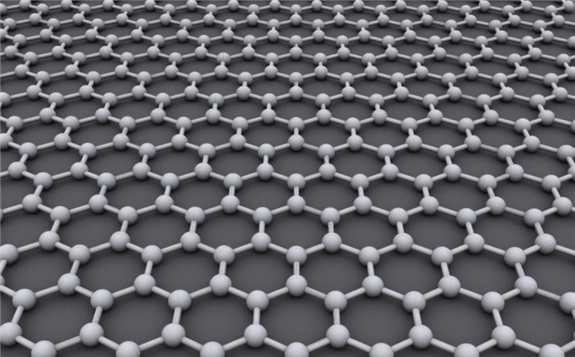Graphene is the thinnest material known to man, and it is made of a single atom thick layer of carbon arranged in a hexagonal lattice. Graphene has found its way into many applications, including batteries, computers, transistors, DNA sequencing, etc.
 Graphene is an atomic-scale hexagonal lattice made of carbon atoms. Image: AlexanderAlUS
Graphene is an atomic-scale hexagonal lattice made of carbon atoms. Image: AlexanderAlUS
Three years ago, physicists from the University of Arkansas developed freestanding graphene that ripples and buckles in a way that promises energy harvesting. The recent finding, published in the journal Physical Review E, provides proof for the theory.
According to Paul Thibado, professor of physics and lead researcher in the discovery, “An energy-harvesting circuit based on graphene could be incorporated into a chip to provide clean, limitless, low-voltage power for small devices or sensors.”
According to the well-known physicists Richard Feynman, the thermal motion of atoms, also known as the Brownian motion, cannot do work. The recent finding refutes this idea, and Thibado’s team found that the Brownian motion in graphene induces an alternating current in the circuit.
Physicist Léon Brillouin’s landmark paper, published in the 1950s, refutes the idea that adding a single diode to a circuit is the solution to harvesting energy from Brownian motion. Hence the physicists built their circuit with two diodes in opposition for converting AC into a direct current (DC). This setup allows current to flow both ways, producing a pulsing DC that performs work on a load resistor.
They discovered that the rate of change in the resistance provided by the diodes amplified the power delivered, rather than reducing it as previously thought.
According to Pradeep Kumar, co-author and associate professor of physics, to prove that the diodes amplified the circuit’s power, the team used a relatively new field of physics.
“In proving this power enhancement, we drew from the emergent field of stochastic thermodynamics and extended the nearly century-old, celebrated theory of Nyquist,” said Kumar.
Even though the thermal environment is performing work on the load resistor, the graphene and the circuit are at the same temperature, and there is no exchange of heat between the two. Any temperature difference would violate the second law of thermodynamics.
The team also discovered that the induced electric current is of low frequency due to graphene’s relatively slow motion. From a technological standpoint, this is significant as electronics function more efficiently at lower frequencies.
In general, the current flowing in a resistor would generate heat. But Brownian current does not; what the physicists did was reroute the current in the circuit and transform it into something useful.
The next objective is to determine if they can store this DC in a capacitor for later use. It would require miniaturizing and patterning it on a silicon wafer. Millions of these tiny circuits on a 1mm by 1mm chip can serve as a low-power battery replacement.







